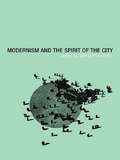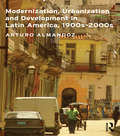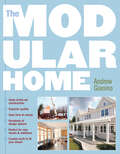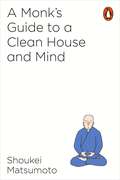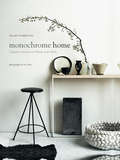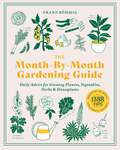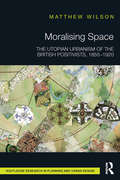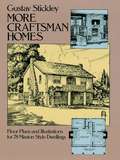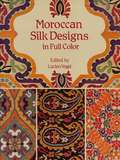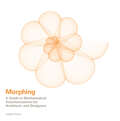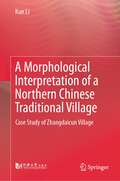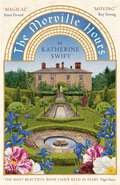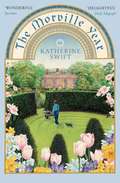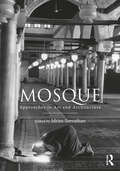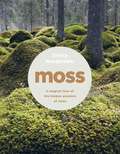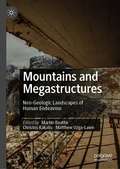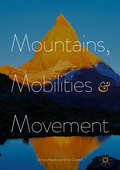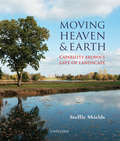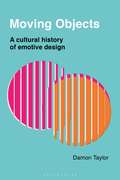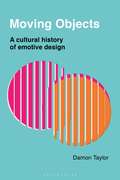- Table View
- List View
Modernism and the Spirit of the City
by Iain Boyd WhyteModernism and the Spirit of the City offers a new reading of the architectural modernism that emerged and flourished in Europe in the first half of the twentieth century. Rejecting the fashionable postmodernist arguments of the 1980s and '90s which damned modernist architecture as banal and monotonous, this collection of essays by eminent scholars investigates the complex cultural, social, and religious imperatives that lay below the smooth, white surfaces of new architecture.
Modernization, Urbanization and Development in Latin America, 1900s - 2000s (Planning, History and Environment Series)
by Arturo AlmandozIn this book Arturo Almandoz places the major episodes of Latin America’s twentieth and early twenty-first century urban history within the changing relationship between industrialization and urbanization, modernization and development. This relationship began in the early twentieth century, when industrialization and urbanization became significant in the region, and ends at the beginning of the twenty-first century, when new tensions between liberal globalization and populist nationalism challenge development in the subcontinent, much of which is still poverty stricken. Latin America’s twentieth-century modernization and development are closely related to nineteenth-century ideals of progress and civilization, and for this reason Almandoz opens with a brief review of that legacy for the different countries that are the focus of his book – Mexico, Chile, Brazil, Argentina and Venezuela – but with references to others. He then explores the regional distortions, which resulted from the interaction between industrialization and urbanization, and how the imbalance between urbanization and the productive system helps to explain why ‘take-off’ was not followed by the ‘drive to maturity’ in Latin American countries. He suggests that the close yet troublesome relationship with the United States, the recurrence of dictatorships and autocratic regimes, and Marxist influences in many domains, are all factors that explain Latin America’s stagnation and underdevelopment up to the so-called ‘lost decade’ of 1980s. He shows how Latin America’s fate changed in the late twentieth and early twenty-first century, when neoliberal programmes, political compromise and constitutional reform dismantled the traditional model of the corporate state and centralized planning. He reveals how economic growth and social improvements have been attained by politically left-wing yet economically open-market countries while others have resumed populism and state intervention. All these trends make up the complex scenario for the new century – especially when considered against the background of vibrant metropolises that are the main actors in the book.
Modernization, Urbanization and Development in Latin America, 1900s - 2000s (Planning, History and Environment Series)
by Arturo AlmandozIn this book Arturo Almandoz places the major episodes of Latin America’s twentieth and early twenty-first century urban history within the changing relationship between industrialization and urbanization, modernization and development. This relationship began in the early twentieth century, when industrialization and urbanization became significant in the region, and ends at the beginning of the twenty-first century, when new tensions between liberal globalization and populist nationalism challenge development in the subcontinent, much of which is still poverty stricken. Latin America’s twentieth-century modernization and development are closely related to nineteenth-century ideals of progress and civilization, and for this reason Almandoz opens with a brief review of that legacy for the different countries that are the focus of his book – Mexico, Chile, Brazil, Argentina and Venezuela – but with references to others. He then explores the regional distortions, which resulted from the interaction between industrialization and urbanization, and how the imbalance between urbanization and the productive system helps to explain why ‘take-off’ was not followed by the ‘drive to maturity’ in Latin American countries. He suggests that the close yet troublesome relationship with the United States, the recurrence of dictatorships and autocratic regimes, and Marxist influences in many domains, are all factors that explain Latin America’s stagnation and underdevelopment up to the so-called ‘lost decade’ of 1980s. He shows how Latin America’s fate changed in the late twentieth and early twenty-first century, when neoliberal programmes, political compromise and constitutional reform dismantled the traditional model of the corporate state and centralized planning. He reveals how economic growth and social improvements have been attained by politically left-wing yet economically open-market countries while others have resumed populism and state intervention. All these trends make up the complex scenario for the new century – especially when considered against the background of vibrant metropolises that are the main actors in the book.
The Modular Home
by Andrew GianinoModular homes are the perfect solution if you want to build a high-quality, customized home without undue expense or hassle. In this informative guide, Andrew Gianino helps you make the best choices throughout the modular building process, with suggestions for everything from choosing the right dealer and contractor to setting the specs, price, and schedule. Whether you&’re looking for a cozy Victorian or want to add a personal touch to a wide ranch, there&’s a modular home that will fit your tastes, lifestyle, and budget.
A Monk's Guide to a Clean House and Mind: Housekeeping Secrets From The World's Tidiest Monks
by Shoukei MatsumotoCleanliness is next to enlightenment. In this Japanese bestseller a Buddhist monk explains the traditional cleaning techniques that will help cleanse not only your house - but your soul.'We remove dust to sweep away our worldly desires. We scrub dirt to free ourselves of attachments. We live simply and take time to contemplate the self, mindfully living each moment. It's not just monks that need to live this way. Everyone in today's busy world today needs it.The Zen sect of Buddhism is renowned for the cleanliness of its monks, but cleaning is greatly valued in Japanese Buddhism in general as a way to cultivate the mind. In this book, I introduce everyday cleaning methods typically employed in temples, while sharing what it's like to be a monk in training.This book will improve the condition not just of your own mind, but also the people around you. I hope readers will discover that cleanliness is an opportunity to contemplate oneself.'
Monochrome Home
by Hilary RobertsonDecorating in black and white is perennially popular and eternally chic. Hilary Robertson demonstrates how, whether used alone or together, these contrasting shades can create dramatic effects at home, from the classic to the eclectic.
The Month-by-Month Gardening Guide: Daily Advice for Growing Flowers, Vegetables, Herbs, and Houseplants
by Franz Bohmig&“Bursting with useful advice, especially for new gardeners.&” —Booklist To be a successful gardener, you need to know two things: how to do something and when to do it. Both concepts are thoroughly tackled in The Month-By-Month Gardening Guide. This comprehensive approach to gardening guides home gardeners—whether you are growing vegetables, flowers, or houseplants—through a year of growing. Throughout, the emphasis is on organic, wildlife-friendly techniques. By following the guidance detailed in this hardworking primer, you&’ll be well on your way to a beautiful and bountiful garden that will provide pleasure throughout the year.
Moralising Space: The Utopian Urbanism of the British Positivists, 1855-1920
by Matthew WilsonAmidst the soot, stink and splendour of Victorian London, a coterie of citizen-sociologists set out to break up the British Empire. They were the followers of the French philosopher Auguste Comte, a controversial figure who introduced the modern science of sociology and the republican Religion of Humanity. Moralising Space examines how from the 1850s Comte’s British followers practised this science and religion with the aim to create a global network of 500 utopian city-states. Curiously the British Positivists’ work has never been the focus of a full-length study on modern sociology and town planning. In this intellectual history, Matthew Wilson shows that through to the interwar period affiliates to the British Positivist Society – Richard Congreve, Frederic Harrison, Charles Booth, Patrick Geddes and Victor Branford – attempted to realise Comte’s vision. With scarcely used source material Wilson presents the Positivists as an organised resistance to imperialism, industrial exploitation, poverty and despondency. Much to the consternation of the church, state and landed aristocracy they organised urban interventions, led ad hoc sociological surveys and published programmes for realising idyllic city-communities. Effectively this book contributes to our understanding of how Positivism, as a utopian spatial design praxis, heavily influenced twentieth-century architecture and planning.
Moralising Space: The Utopian Urbanism of the British Positivists, 1855-1920
by Matthew WilsonAmidst the soot, stink and splendour of Victorian London, a coterie of citizen-sociologists set out to break up the British Empire. They were the followers of the French philosopher Auguste Comte, a controversial figure who introduced the modern science of sociology and the republican Religion of Humanity. Moralising Space examines how from the 1850s Comte’s British followers practised this science and religion with the aim to create a global network of 500 utopian city-states. Curiously the British Positivists’ work has never been the focus of a full-length study on modern sociology and town planning. In this intellectual history, Matthew Wilson shows that through to the interwar period affiliates to the British Positivist Society – Richard Congreve, Frederic Harrison, Charles Booth, Patrick Geddes and Victor Branford – attempted to realise Comte’s vision. With scarcely used source material Wilson presents the Positivists as an organised resistance to imperialism, industrial exploitation, poverty and despondency. Much to the consternation of the church, state and landed aristocracy they organised urban interventions, led ad hoc sociological surveys and published programmes for realising idyllic city-communities. Effectively this book contributes to our understanding of how Positivism, as a utopian spatial design praxis, heavily influenced twentieth-century architecture and planning.
More Craftsman Homes
by Gustav StickleyGustav Stickley (1858-1942) -- leader of the American Arts and Crafts Movement, publisher of The Craftsman, writer, innovator, and famous furniture manufacturer -- created designs for a new form of American home. Based on beauty, simplicity, utility, and organic harmony, these designs were to have lasting impression on the shape, look, feel, and rationale of American domestic architecture.Many of the features advocated by Stickley exist today: split-levels, semi-partitions, an integration of structure with natural surroundings, and the primacy of form following function. Here, in 345 crisp black-and-white illustrations, are 78 authentic Mission style dwellings. These are the plans that Stickley himself approved -- reprinted directly from the original 1912 publications -- and include illustrations of the exteriors and interiors, floor plans, elevations, structural suggestions, landscape designs, and Stickley's own inimitable comments.Deeply influenced by the English Arts and Crafts Movement, especially the writings of John Ruskin and William Morris, Stickley rebelled against the outmoded architectural traditions of the Victorian age. Instead of creating rooms that were a series of separate cells, he proposed letting one living area flow smoothly into the other; instead of imitating the styles of 19th-century Europe, he proposed an original and vital American style, all the while searching for a new vocabulary of exterior and interior design. His method was the simplification of architectural space and the elimination of superfluous ornamentation; his aim was a harmonious blend of utility, economy, and aesthetics.The ideal of the Craftsman home was an honest and beautiful building, well planned for efficient use of space and materials, built to last several generations, and within the means of the average family. Craftsman architecture adhered to four basic principles: a style of building suited to the ways people actually lived; having the best structural outline and the simplest form; made from materials that belong to the countryside in which the house was built and in harmony with the landscape; and rendered in colors that please and cheer. For Stickley, the true beauty of a building was not a matter of decoration -- a something to be added -- but was inherent in the very lines and masses of the structure itself.This excellent republication of Gustav Stickley's More Craftsman Homes affords a fresh look at an influential and thoroughly American style of design and construction. Today's architects, designers, decorators, and collectors of Americana will find in the text and illustrations of this volume sufficient information and insight to appreciate the Craftsman home, the Craftsman idea, and that innovative spirit who made it possible, Gustav Stickley.
Moroccan Silk Designs in Full Color (Dover Pictorial Archive)
by Lucien VogelGathered from a rare French portfolio, here are 59 exquisite, royalty-free motifs — mainly florals and foliates — incorporating Romanesque, Byzantine, Persian, Far Eastern, and traditional Moroccan motifs.Fès (Fez), one of the oldest and most important cities in Morocco, has long been a center for the practice of Islamic crafts, including brasswork, leatherwork, pottery, textiles, and embroidery. Among the most admired textiles produced in the city are the ornamental belts women wear under their caftans on festive occasions. Originally the designs were simple and the colors somber, but over the years the complexity of design increased and the colors became more flamboyant. One startling effect is the sudden change of coloration of a pattern in the same belt, as shown in several of the plates included here. In some instances, there is a sudden discontinuity of pattern within one woven fabric; in others, two patterns from two fabrics sewn together.At the center of commerce in the Near East, Fès was subject to many influences, some of which — including Romanesque, Byzantine, Persian, Rhodian, and Far Eastern textiles — are reflected in these designs. Two motifs are typically Moroccan: a combination of the hand of Fatima and Solomon's Seal; and the mihrab and minbar of mosque architecture.
Morphing: A Guide to Mathematical Transformations for Architects, Designers
by Joseph ChomaCylinders, spheres and cubes are a small handful of shapes that can be defined by a single word. However, most shapes cannot be found in a dictionary. They belong to an alternative plastic world defined by trigonometry: a mathematical world where all shapes can be described under one systematic language and where any shape can transform into another.This visually striking guidebook clearly and systematically lays out the basic foundation for using these mathematical transformations as design tools. It is intended for architects, designers, and anyone with the curiosity to understand the link between shapes and the equations behind them.
A Morphological Interpretation of a Northern Chinese Traditional Village: Case Study of Zhangdaicun Village
by Kun LiThis book challenges the definition of a new approach for integrating protection and enhancing the Chinese heritage category of “Traditional Villages”. By applying a specific case study in the Hancheng context, Shaanxi Province, which lacks sound studies, the book formulates new theoretical prerequisites for future re-searches, an in-depth knowledge path, and sound methodological principles. By working in a multiple scales approach, the object of preservation and enhancement is first of all redefined in its ontology as a unity formed by the courtyard type, the morphology of the village, and the related landscape structures. All these three levels of study have been deeply investigated, put into the relationship and resulting in a new methodology which overcomes the inadequacy and ineffectiveness of the notion of “setting” deriving from conservation Charters, to embrace the structural notion of “context” and a knowledge approach to rural settlements’ form. The innovative and original features of this book are both in the reading villages in their landscape dimension, which in turn is studied as a context made of several interrelated structures. Another original feature of the book is the integration of Italian historic-structural and morphological methodologies with specific Chinese cultural aspects. The author’s work dug deeply and interdisciplinary in all those dimensions to account for the complex issues that are related and embodied in both the physical and intangible meaning of human settlements, opening a novel scientific methodology for Chinese studies as a sound base to define three key integrated project actions: what, why, how to preserve, enhance, develop.
Mortgage Free!: Innovative Strategies for Debt-Free Home Ownership, 2nd Edition
by Robert L. Roymort•gage (mor´-gij) n. from Old French morgage, mort gage, literally “death pledge” As a wave of foreclosures sweeps the country, many people are giving up hope for owning a home of their own. They have good reason to turn their backs on the banks, but not on their dreams. In this revised edition of Mortgage Free!, Rob Roy offers a series of escape routes from enslavement to financial institutions, underscored by true stories of intrepid homeowners who have put their principles into action. From back-to-the-land homesteads to country homes, here is a complete guide to strategies that allow you to own your land and home, free and clear, without the bank. Included is detailed advice about: Clarifying and simplifying your notions of what’s necessary Finding land that you love and can afford Taking control of the house-building process, for the sake of sanity and pleasure Learning to take a long-term perspective on your family’s crucial economic decisions, avoiding debt and modern-day serfdom
The Morville Hours: The Story of a Garden
by Katherine SwiftIn 1988 Katherine Swift arrived at the Dower House at Morville to create a garden of her own. This beautifully written, utterly absorbing book is the history of the many people who have lived in the same Shropshire house, tending the same soil, passing down stories over the generations. Spanning thousands of years, The Morville Hours takes the form of a medieval Book of Hours. It is a meditative journey through the seasons, but also a journey of self-exploration. It is a book about finding one's place in the world and putting down roots.
The Morville Year
by Katherine SwiftOne of the most admired gardening writers of her generation, Katherine Swift returns to describe a year in the life of her garden she created over twenty years in the grounds of the Dower House at Morville, Shropshire, meditating on everything from the terrain and its history, to the plants and trees, and the odd habits of the animals and humans who inhabit the garden.Following the turning wheel of the Morville seasons, from the green shoots of spring, through summer and autumn, to the stark beauty of winter, and back to spring again, The Morville Year is a journal full of surprises and enchantments that will appeal not only to gardeners, but to all who enjoy the natural world.
Mosque: Approaches to Art and Architecture
by Idries TrevathanMosque examines the history, culture, evolution and functions of the Muslim house of worship through the prism of its artistic objects and architectural elements. Contributors present a range of elements, from dome to mihrab, to mosque furniture including lamps, prayer rugs and Qur’an stands. In addition, the book draws attention to the importance of mosque heritage through special projects and initiatives that study, preserve and revitalize the traditional arts of the mosque. This unique book brings together prominent architects, art historians, artists, historians and curators to explore innovative approaches towards the study of mosques through the presentation of original research and insights about mosque-related cultural objects. It is essential reading for anyone interested in the art and culture of the Muslim world.
Mosque: Approaches to Art and Architecture
Mosque examines the history, culture, evolution and functions of the Muslim house of worship through the prism of its artistic objects and architectural elements. Contributors present a range of elements, from dome to mihrab, to mosque furniture including lamps, prayer rugs and Qur’an stands. In addition, the book draws attention to the importance of mosque heritage through special projects and initiatives that study, preserve and revitalize the traditional arts of the mosque. This unique book brings together prominent architects, art historians, artists, historians and curators to explore innovative approaches towards the study of mosques through the presentation of original research and insights about mosque-related cultural objects. It is essential reading for anyone interested in the art and culture of the Muslim world.
Moss
by Ulrica NordströmExplore the magical world of moss, with this fully-illustrated and comprehensive guide. Moss is all around us. While it is most often associated with damp, shady spaces, it can be found in the most unexpected and far-flung places, from deserts to Antarctica. This book is a celebration of its quiet, unassuming beauty and a primer to understanding the secrets of the world's most ancient plant: · Discover the fascinating history of this soft and tactile plant · Learn how and where to identify and gather different moss species.· Take a tour of some of the most beautiful moss gardens in the UK, the US and Japan, where moss viewing has become a national phenomenon.· Learn how to cultivate moss, tie Japanese moss balls (kokedama) and plant moss landscapes in pots and terrariums.With stunning photography and botanical illustration, this is an utterly unique book that will be treasured by plant enthusiasts of all kinds.
Mountains and Megastructures: Neo-Geologic Landscapes of Human Endeavour
by Martin Beattie Christos Kakalis Matthew Ozga-LawnThis book explores the shared qualities of mountains as naturally-formed landscapes, and of megastructures as manmade landscapes, seeking to unravel how each can be understood as an open system of complex network relationships (human, natural and artificial). By looking at mountains and megastructures in an interchangeable way, the book negotiates the fixed boundaries of natural and artificial worlds, to suggest a more complex relationship between landscape and architecture. It suggests an ecological understanding of the interconnectedness of architecture and landscape, and an entangled network of relations. Urban, colonialist, fictional, rural and historical landscapes are interwoven into this fabric that also involves discontinuities, tensions and conflicts as parts of a system that is never linear, but rather fluid and organic as driven by human endeavor.
Mountains, Mobilities and Movement
by Christos Kakalis Emily GoetschThis book explores the moving qualities of mountains by utilising theories, ideas and processes which contribute to a larger understanding of these geological forms. In highlighting the fluid attributes of mountains the authors offer an alternative to the traditional approach of the sciences and the humanities, which address mountains as static geological or geographical features. The essays in this collection posit that movement impacts the relationship between society and mountains – travelling landscape objects, constructing design and artistic translations, climbing and experiencing changing atmospheres and the different ways of seeing from mountain peaks – and that physical, intellectual and spiritual motion is integral to their understanding. This innovative collection will be of great interest to scholars of geography, art, architecture, history, theology and philosophy.
Moving Heaven and Earth: Capability Brown's Gift of Landscape
by Steffie ShieldsThis beautifully illustrated book, with the vast majority of illustrations photographed by the author, makes a fitting tribute to the world-famous 18th century landscape architect Lancelot ‘Capability’ Brown (1716-1783) in his Tercentenary year. Moving Heaven and Earth reveals the driven polymath behind the famous nickname. It explores both Brown’s artistic legacy and his pioneering work with water in the landscape. The book evaluates the rise of the English landscape garden in the climatic context of his designs and also forms a comprehensive guide for tours and visits. Approximately 350 clearly labelled colour photographs, pin-point Brown’s enduring views and surprisingly vibrant planting palette.
Moving Objects: A Cultural History of Emotive Design
by Damon TaylorMoving Objects deals with emotive design: designed objects that demand to be engaged with rather than simply used. These emotionally laden, highly authored works are often produced in limited editions and sold like art. Examples given in the book include a chair made from cuddly toys, a leather sofa that resembles a cow, and a jewellery box fashioned from human hair. If Postmodernism demanded ironic distance, and Critical Design is all about questions, then emotive design runs hotter than this, confronting how designers are using feelings in what they make.Tracing the phenomenon back to the 'Dutch inflection' that began with Droog designers like Jurgen Bey and Hella Jongerius, Moving Objects follows the development of such work back through Italian radical design and looks for its origins in the uncanny explorations of surrealism. Through analysis of the rising popularity of designer-makers like Nacho Carbonell and Studio Swine, the book establishes a critical and theoretical framework for understanding the performative nature of this emotive and sometimes disturbing work. Through a critique of Speculative Design, and an examination of the work of designers such as Mathias Bengtsson who are 'growing' furniture inside computers, the book asks what happens when the tangible melts into the datascape and design becomes a question of mobilities. In this way, Moving Objects examines contemporary issues of how we live with artefacts and what design can do.
Moving Objects: A Cultural History of Emotive Design
by Damon TaylorMoving Objects deals with emotive design: designed objects that demand to be engaged with rather than simply used. These emotionally laden, highly authored works are often produced in limited editions and sold like art. Examples given in the book include a chair made from cuddly toys, a leather sofa that resembles a cow, and a jewellery box fashioned from human hair. If Postmodernism demanded ironic distance, and Critical Design is all about questions, then emotive design runs hotter than this, confronting how designers are using feelings in what they make.Tracing the phenomenon back to the 'Dutch inflection' that began with Droog designers like Jurgen Bey and Hella Jongerius, Moving Objects follows the development of such work back through Italian radical design and looks for its origins in the uncanny explorations of surrealism. Through analysis of the rising popularity of designer-makers like Nacho Carbonell and Studio Swine, the book establishes a critical and theoretical framework for understanding the performative nature of this emotive and sometimes disturbing work. Through a critique of Speculative Design, and an examination of the work of designers such as Mathias Bengtsson who are 'growing' furniture inside computers, the book asks what happens when the tangible melts into the datascape and design becomes a question of mobilities. In this way, Moving Objects examines contemporary issues of how we live with artefacts and what design can do.
